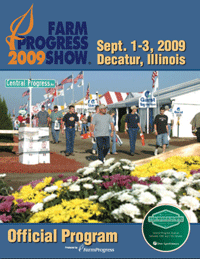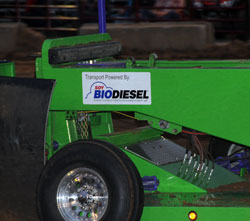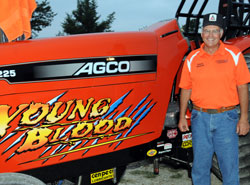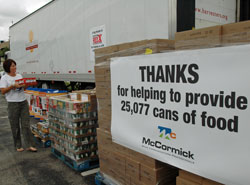 The first big news at the Farm Progress Show was the announcement by New Holland, our sponsor, of their new utility vehicle called The Rustler. Carly is seen here in the driver seat of the one we have on display in the media tent.
The first big news at the Farm Progress Show was the announcement by New Holland, our sponsor, of their new utility vehicle called The Rustler. Carly is seen here in the driver seat of the one we have on display in the media tent.
New Holland announces a new product for the hardworking rancher, farmer or property owner and the hardplaying outdoor sports enthusiast: the Rustler™ utility vehicle. Equally at home at work or play, Rustler™ utility vehicles combine rugged performance with an ultra-smooth ride for “go-anywhere, do-anything” confidence. No matter what you do, a New Holland Rustler can be built for you!
In fields and woods, over ruts and rocky roads, through mud or snow, Rustler UVs get the job done. Whether hauling supplies, pulling trailers or transporting people and gear, Rustler UVs can be configured to meet the need: they are offered in two-passenger or four-passenger versions, with gas or diesel engines, 4×2 or 4×4 axles, and with a wide variety of options and accessories.
Full news release here.
Farm Progress Show Photo Album
AgWired coverage of the 2009 Farm Progress Show
is sponsored by:  and
and 



 It’s that time. Time for the 2009 Farm Progress Show. I know a lot of people and a lot of work has been going on in Decatur, IL already and I’ll be on location tomorrow afternoon. Cindy and Carly will be going to their first FPS. It looks like they’ll have some great weather. That’ll be a change.
It’s that time. Time for the 2009 Farm Progress Show. I know a lot of people and a lot of work has been going on in Decatur, IL already and I’ll be on location tomorrow afternoon. Cindy and Carly will be going to their first FPS. It looks like they’ll have some great weather. That’ll be a change.
 To make their point in a pretty funny way, ALG released this
To make their point in a pretty funny way, ALG released this  What do you think of when you hear that there’s a sled running on biodiesel? Probably not thinking tractor pull sled are you? Unless you’re a tractor pull fan. Well those big machines that the tractors and trucks pull are also diesel powered and in Jefferson City, MO there’s a company that manufactures them and runs them on biodiesel.
What do you think of when you hear that there’s a sled running on biodiesel? Probably not thinking tractor pull sled are you? Unless you’re a tractor pull fan. Well those big machines that the tractors and trucks pull are also diesel powered and in Jefferson City, MO there’s a company that manufactures them and runs them on biodiesel. Donnie says they do over 160 shows a year around the country. At the Midwest Extreme Truck and Tractor Pull in Jefferson City he says they had two sleds in operation. He says they run B20 in them and have been for over 3 years very successfully. Donnie says they’ve had a lot of luck locating the fuel when they need it, especially at major truck stops.
Donnie says they do over 160 shows a year around the country. At the Midwest Extreme Truck and Tractor Pull in Jefferson City he says they had two sleds in operation. He says they run B20 in them and have been for over 3 years very successfully. Donnie says they’ve had a lot of luck locating the fuel when they need it, especially at major truck stops. This soybean grower from Missouri doesn’t plant corn with the machine he’s standing next too. No way. But he does power it with a biodiesel blend and compete in tractor pulls across the United States. He’s Dennis Shramek and one of the competitors in this weekend’s NTPA Midwest Extreme Truck and Tractor Pull. Thank you to the
This soybean grower from Missouri doesn’t plant corn with the machine he’s standing next too. No way. But he does power it with a biodiesel blend and compete in tractor pulls across the United States. He’s Dennis Shramek and one of the competitors in this weekend’s NTPA Midwest Extreme Truck and Tractor Pull. Thank you to the  John Deere has once again come out with a whole list of new product announcements. The big one is about their introduction of the
John Deere has once again come out with a whole list of new product announcements. The big one is about their introduction of the  McCormick Company is celebrating 20 years in business and held a great event yesterday to not only enjoy this milestone but assist a good cause at the same time. Thanks to Janell Aust for the information and photo.
McCormick Company is celebrating 20 years in business and held a great event yesterday to not only enjoy this milestone but assist a good cause at the same time. Thanks to Janell Aust for the information and photo. “There’s really no better way to celebrate being a part of the Kansas City community,” said Mark Perrin, President of McCormick Company. “We get to help families in Kansas City by teaming up with local businesses and companies to reach our goal. We’re very pleased with the successful outcome.”
“There’s really no better way to celebrate being a part of the Kansas City community,” said Mark Perrin, President of McCormick Company. “We get to help families in Kansas City by teaming up with local businesses and companies to reach our goal. We’re very pleased with the successful outcome.”